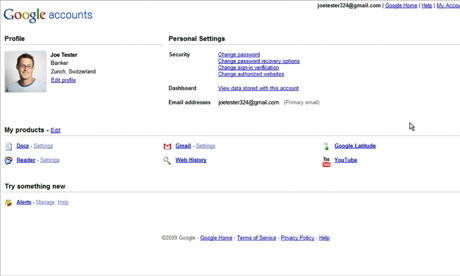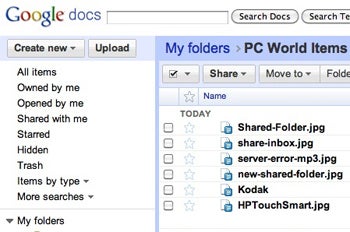Google Docs, a hosted suite of office productivity applications, still has a ways to go in its development, but users can expect dramatic changes in the next 12 months.
So said Dave Girouard, president of Google's Enterprise unit, at the Bank of America and Merrill Lynch 2009 U.S. Technology Conference on Thursday.
After acknowledging that Google has "a lot of work to do" to improve Docs, and that the suite isn't yet a "full on" replacement for Microsoft Office, nor the open-source OpenOffice, Girouard said big improvements are coming.
"In a year, those products will be night and day from what they are today," he said, referring to the word-processing, spreadsheet and presentation software in Docs.
While Google has always acknowledged that Docs doesn't match all of the Microsoft Office features, it also has pointed out that, as Web-hosted software, it offers collaboration capabilities its PC-based competitor can't.
Girouard wasn't specific about what Docs features need to improve, but his comments sounded like a general acknowledgement that, even with its collaboration advantages, Docs has to improve its user experience to get people to view it as a more credible alternative to other office suites.
Girouard, whose presentation was webcast, said that Gmail and Calendar are much more mature products and thus drive the decisions of most businesses to adopt the Appscollaboration and communication suite, which also includes Docs.
Apps customers will also see more effort by Google to attract enterprise developers to its App Engine hosted application development environment, which recently gained Java support and became generally available, after a period of limited release.
Google will also continue enhancing the Gmail and Calendar components with improvements aimed at CIOs and IT managers, including the upcoming Apps Connector for BlackBerry Enterprise Server, he said.
Ironically, the economic downturn and the ensuing reductions in IT budgets have caused a spike in interest in the Premier version of Apps, which can cost between five and 20 times less than Microsoft's Office and Exchange, he said.
Apps Premier costs US$50 per user, per year and, as the most sophisticated version of the suite, is geared toward businesses with more than 50 end-users, which is the maximum for the Standard version, which carries ads in Gmail and is free. There is also a free Education edition designed for schools and universities. Most Apps users are small businesses.
While happy with the gradual but steady growth of Apps' adoption by large enterprises, Girouard acknowledged that security concerns about Web-hosted software remain a big obstacle.
"We're very early in this thing and most CIOs are still scared to death with the idea of their data being outside of their firewall in someone else's data centers," said Girouard, who answered questions from a financial analyst and from audience members.
Google maintains that those concerns are unwarranted, saying data is more secure in one of its data centers than in an organization's data center.
Another challenge for Apps' adoption is CIOs' reluctance to change software that tens of thousands of employees use, Girouard said. "The thought of moving 50,000 end-users to an entirely new experience for something they use every day is very daunting," he said.
Every few weeks, a large enterprise with 10,000 end-users or more migrates to Apps, and every time that happens, momentum continues to build, as well as confidence in the suite itself, as well as in the SaaS (software-as-a-service) model, he said.
One thing that doesn't help CIOs understand SaaS specifically and cloud computing in general is the sudden appropriation of the terms by myriad vendors in order to benefit their marketing efforts, he said.
"It's interesting that everybody is in cloud computing now. In most cases, I view it as a re-labeling of what they were doing five years ago," he said.
Girouard has a particular beef with the term "private clouds" to refer to customer data centers that have been optimized through the use of virtualization technology.
"By no means would I describe that as cloud computing. I'd call that more efficient data centers and getting more out of the servers you buy," he said.
Among the few vendors doing true cloud computing at scale are Google, Salesforce.com and Amazon.com, he said.
"If you're still selling large up-front buildouts of X, Y or Z, regardless of what virtualization is involved, that's not in my mind cloud computing," he said.
Google's Enterprise unit generates "a few hundred million dollars" in revenue, is profitable and is growing, Girouard said.
Its revenue is just a small fraction of Google's total revenue, which mostly comes from online advertising, but growing that percentage isn't his focus.
"I'm not competing with the rest of Google. I'm looking to build a very large business over a long period of time," he said.
The opportunities in IT enterprise search and Web-hosted business software are big. "We can be a first-tier player in IT," he said.
"We're not driving Google's top or bottom line in 2009, and probably not in 2010, for that matter. Having said that, we can grow for many years in this business and build a very large business over time," he said.
 In a move apparently aimed at mounting an even bigger challenge to the iPhone Google has confirmed that it is working on an own brand smartphone, one that might bear the name Nexus-one, and could go on sale as early as next month.
In a move apparently aimed at mounting an even bigger challenge to the iPhone Google has confirmed that it is working on an own brand smartphone, one that might bear the name Nexus-one, and could go on sale as early as next month. 
 According to Marissa Mayer, Google’s vice president of search product and user experience, Google is looking to streamline its search experience. Using a jazz metaphor, Mayer explains that customers aren’t happy with the fact that Google’s search interface is too unpredictable (much like jazz, especially if you aren’t into it) at times.
According to Marissa Mayer, Google’s vice president of search product and user experience, Google is looking to streamline its search experience. Using a jazz metaphor, Mayer explains that customers aren’t happy with the fact that Google’s search interface is too unpredictable (much like jazz, especially if you aren’t into it) at times.


 Google is providing the web development community with an intriguing glimpse under the hood at some of the fundamental building blocks of the company's most popular web applications. The search giant has opened the source code of its comprehensive JavaScript library collection and is making it available to third-party developers for widespread adoption. Google also opened the source code of its own JavaScript compression tools.
Google is providing the web development community with an intriguing glimpse under the hood at some of the fundamental building blocks of the company's most popular web applications. The search giant has opened the source code of its comprehensive JavaScript library collection and is making it available to third-party developers for widespread adoption. Google also opened the source code of its own JavaScript compression tools. 



 . Too bad. But luckily, before they did, TechCrunch reader and Linux user, Jonathan Frederickson, was able to grab the code and managed to install it. He has posted some results in our comments section and even more on his blog.
. Too bad. But luckily, before they did, TechCrunch reader and Linux user, Jonathan Frederickson, was able to grab the code and managed to install it. He has posted some results in our comments section and even more on his blog.















 Start using open web technologies - like the HTML5
Start using open web technologies - like the HTML5 

 Features that Google brought to its developer preview version of Chrome--themes, a revamped new-tab page, a tweaked Omnibox for searching and entering Web addresses, and support for HTML 5 video--have now arrived on the browser's better tested beta version intended for broader use.
Features that Google brought to its developer preview version of Chrome--themes, a revamped new-tab page, a tweaked Omnibox for searching and entering Web addresses, and support for HTML 5 video--have now arrived on the browser's better tested beta version intended for broader use.



 The mobile voice search engine, custom-built by Google India has been launched by Google India, free for mobile services subscribers in India. However, the voice-based search engine services are currently limited to BlackBerry users.
The mobile voice search engine, custom-built by Google India has been launched by Google India, free for mobile services subscribers in India. However, the voice-based search engine services are currently limited to BlackBerry users.